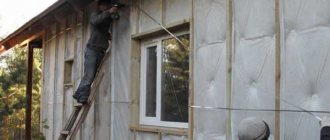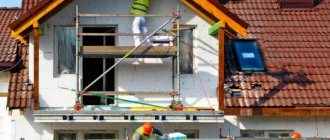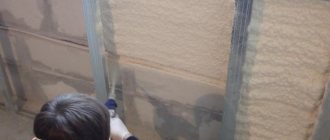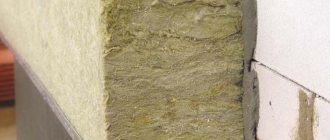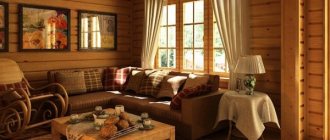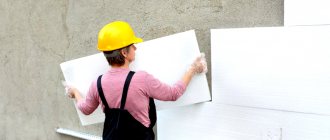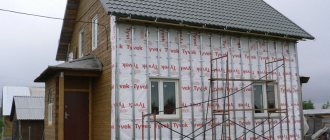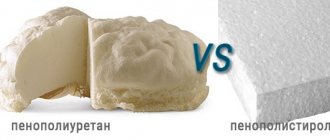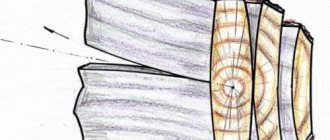High-quality insulation of the exterior of a house allows you to maintain the microclimate in a living space at a comfortable level by reducing heat losses in cold weather and excessive heating in hot summers. The home owner gets the opportunity to save on heating or air conditioning. There are many ways to insulate the external walls of a house based on various materials, and the main task is to choose the most optimal option.
Facade insulation Source interistroy.ru
Advantages of an insulated facade
Applying additional layers to the outer surface to insulate a building allows you to:
- Prevent premature destruction of walls from exposure to an aggressive natural environment.
- Improve the appearance of your home.
- Eliminate condensation on the internal walls.
- Reduce noise penetration.
- Reduce heat exchange between the outside and inside of the house.
You can insulate a facade on your own, although this is a labor-intensive and complex process, and mistakes are difficult to eliminate and will reduce the expected effect many times over. At the same time, there are a huge number of companies offering their services in this direction. The main thing is to find one that will provide the necessary quality at a reasonable cost.
For insulation, it is better to use the services of professionals Source archidea.com.ua
Preparing walls for gluing insulation, treating with antifungal agents and primers
Preparation of the construction foundation should include the following operations:
- mechanical cleaning of the base from mortar residues, contaminants (dust, chalk, etc.)
- mechanical removal of fungi, lichens, mosses, blue-green algae, mold and subsequent treatment of the affected areas with the antifungal agent Ceresit CT99, work performed in accordance with the work schedule indicated on the Ceresit CT 99 can;
Ceresit CT 99. Antifungal agent (concentrate for protection against biocorrosion) (c) Ceresit
- checking the bearing capacity of the foundation;
- removal of crumbling and weak areas of the base;
- filling defects in the base surface more than 10 mm deep with repair plaster Ceresit CT 24, Ceresit CT 29;
- Ceresit CT 29. Plaster and repair putty for interior and exterior work (layer thickness from 2 to 20 mm) (c) Ceresit
- Ceresit CT 24. Plaster for cellular concrete (layer thickness 3-30 mm) (c) Ceresit
- treating the base with the universal primer Ceresit CT 17 (when working with cellular concrete, silicate and red bricks, multi-slot blocks, expanded clay concrete and other bases, priming should be done with a primer diluted with water in three passes 1x6, 1x4, 1x2, application with a sprayer and spray gun);
Ceresit CT 17. Deep penetration primer (c) Ceresit Priming the facade with CT 17 primer using a paint brush
- Priming the façade with CT 17 primer using a garden sprayer
- Handheld Garden Sprayer
- mechanical application of primer using a machine:
Mechanical application of Ceresit CT 16 primer.
- cleaning of rust and treatment with anti-corrosion primer of metal parts covered with a thermal insulation system;
Insulation material
Materials for insulating facades differ in quality, method of attachment to the wall, and price. Primary requirements:
- Sufficient thermal insulation properties.
- Long service life.
- Durability, moisture resistance.
- Not be a suitable habitat for rodents and other living organisms.
Also, when choosing, you should take into account the thickness of the walls, which may differ in different parts of the house. Keep in mind that insulating the southern wall does not require the use of thick layers.
Insulated facade Source ppu.stroi-izol.ru
It should be emphasized that all the heat insulators presented below in the list are very popular and effectively prevent heat transfer.
Styrofoam
Divided into several types:
- pressless;
- press;
- extruded, most resistant to damage.
Foam insulation Source krovlyakryshi.ru
Advantages:
- The lowest price.
- Easy installation process.
Installation of dowels
Dowels additionally secure the insulation sheets to the facade; they are installed either in accordance with the official recommendations of the system holders, two in the middle of the slab and the rest at the joints of the slab with neighboring slabs.
Installation of dowels according to the diagram. Photo 1.
Or one “star” in the middle and four dowels in the body of the insulation closer to the edges:
- Installation of dowels according to the diagram. Photo 2.
- Installation of dowels according to the diagram. Photo 3.
- Installation of dowels according to the diagram. The “correct” dowel with a metal core. Photo 6.
- Installation of dowels according to the diagram. Photo 4.
- Installation of dowels according to the diagram. Photo 5.
- Installation of dowels according to the diagram. The “correct” dowel with a metal core. Photo 7.
If the insulated wall is made of monolithic reinforced concrete, solid brick, expanded clay concrete, then the expansion zone of the dowel should be 50 mm, the total length of the dowel is approximately the thickness of the insulation + 50 mm.
If the insulated wall is made of foam concrete, aerated concrete, slotted brick, multi-slotted blocks, warm ceramics, then the spacer zone is 100 mm, the total length of the dowel is approximately the thickness of the insulation +100 mm.
The top of the dowels must be carefully covered with CeresitST 85 or ST 190 glue; the coating is done after the final sanding of the surfaces to the three-meter rule.
Video installation of dowels.
Video description
Learn more about foam insulation in this video:
Mineral wool
These are slabs of inorganic fibrous material, made from silicate waste, metallurgical slag, and mixtures of sedimentary rocks. There are several types:
- glass wool (lowest thermal conductivity);
- stone (basalt);
- slag (rarely used).
Mineral wool made in the form of rolls and slabs is suitable for wall insulation, but the latter are more preferable because they have a denser structure.
Insulation with mineral wool Source dneprostroy.dp.ua
Advantages of insulation:
- Waterproof.
- Air exchange.
- Soundproofing.
- Fire resistance.
- Service life 25-50 years.
Flaws:
- It should be protected from moisture, as it quickly absorbs water and loses thermal conductivity.
- It crumbles into fine dust (especially glass wool), so work is carried out in a respirator.
Mineral wool is used in conjunction with a reliable waterproofing material. Fixed to the wall using glue or disc dowels. Basalt wool is more durable. Its price is relatively low.
Ecowool
Made from natural cellulose, it is truly an environmentally friendly material, which cannot be said about inorganic insulation materials, which definitely emit harmful substances, albeit in minimal doses.
Additional components - borax and boric acid, as well as minerals, protect cellulose from rotting and rodents, and increase fire safety.
Ecowool insulation Source otopleniehouse.ru
The loose structure of ecowool dampens sound vibrations. The ventilation characteristics of ecowool, comparable to natural wood, make it very attractive for insulating wooden buildings.
A significant drawback is that the material is applied using wet technology: wet ecowool is sprayed onto the facade. After the moisture evaporates, a dense and warm coating is formed, which firmly adheres to the surface. Plaster, magnesite tiles, and block houses are suitable for finishing. Refers to expensive insulation materials.
Dry spraying is only possible for frame buildings that have voids between the exterior and interior finishes.
Expanded polystyrene (penoplex)
Expanded polystyrene is often chosen for insulating facades. The material has many advantages, but it also has disadvantages that are worth studying.
Penoplex insulation Source ob-otdelke.ru
Pros:
- Light weight, 98% air.
- Does not allow or absorb moisture.
- Resistant to deformation.
- Frost resistance, withstands sudden temperature changes.
- The ease of installation work, which a beginner can carry out, is cut with a simple sharp knife.
- Guarantees high efficiency, costs for air conditioning and heating are reduced by 3 times.
Minuses:
- It only muffles the sound slightly.
- Destroyed by chemically active substances under the influence of ultraviolet rays.
- Fire at a fairly low temperature of 210-440 0C, with the release of harmful substances (however, the presence of self-extinguishing indicators saves).
- Suitable for rodents: additional treatment is required to avoid spread.
- It allows moisture to pass through; at low temperatures it turns into ice, which destroys the insulation.
The tongue-and-groove connection method ensures a tight fit of the slabs. The prices for the material are adequate to the quality.
An expedient choice is thermal panels made of polystyrene foam with clinker tiles; when used, they do not require finishing.
Possible errors when performing work
Most often, beginners make the following mistakes that reduce the quality of their work:
- weak fixation of insulation - causes cracks, detachment and deformation;
- poor preparation of the walls - causes a decrease in adhesion, sliding of the insulation and even a shift in the dew point;
- installation in unsuitable climatic conditions - leads to a reduction in service life;
- loose joining of insulation boards, small overlap of the mesh - provoke cracking of the finish;
- improper treatment of window slopes - allows moisture penetration;
- choosing low-quality plaster is a prerequisite for rapid deterioration of the entire finishing layer.
In order for the home insulation system to serve for a long time and actually cope with the main tasks, it is important to strictly follow the technology and not skimp on materials. Then the house will become beautiful, comfortable and reliable, and will not require repairs for decades!
Insulation technology
Despite the different structure, properties and component components, all insulation materials are installed on the walls of a house in two ways:
- Wet. Guarantees better adhesion of the material to the surface. It is carried out only at positive temperatures.
- Dry. Availability of installation at any time of the year. Wins in speed of work. But it fits less tightly to the wall, which increases heat loss.
Wet method of facade insulation Source 1postroike.ru
Insulation technology depends on the finishing option. For example, it is better to use the wet method for plaster, and the dry method for siding.
Facade thermal panels
For quick and high-quality cladding while simultaneously insulating buildings, use façade panels. This material is a sheet of expanded polystyrene, which is trimmed on one side with ceramic tiles that imitate brickwork.
Facade thermal panels
These elements are glued to the wall and secured to it with dowels, which are installed through “masonry” joints. The installation sites are rubbed down with a special fugue.
Popular warm stenolith facades are created on the basis of unique domestic materials. Their design contains a steel sheet with an aluminum-zinc coating, treated with a special paint. The thermal insulation properties of the panels are provided by a polyurethane foam layer equipped with a foil film.
Advantages of facade thermal panels
- Light weight facade, which does not require a high-strength foundation.
- High speed and ease of installation.
- The protection of insulation and the effectiveness of insulation in general.
- Reasonable price of panels.
Flaws
- Use of "wet" processes.
Organization of insulation and finishing materials
Insulation of the house is carried out after:
- installation of roofing, windows, ventilation;
- foundation finishing;
- shrinkage of the building.
Above-zero, dry weather is preferred.
The façade cladding is a multi-layer structure assembled in a certain sequence from different types of materials, each performing a specific function. An important factor is how to insulate the exterior of a house. It largely determines the technology of the entire process.
Insulation under siding
Insulation under siding Source stroyfora.ru
The sequence of work with dry insulation technology is as follows:
- A frame supporting system is used. For a two-layer installation with anchor elements, vertical guides made of a metal profile or wooden block are attached, then horizontal, with the condition that the joints overlap.
- The insulation is laid in rows, starting from the bottom of the wall.
- A windproof, vapor-permeable film is applied.
- Galvanized screws are used to screw the siding panels to a metal or wooden frame.
With the wet method, the wall is brought into proper condition, cleaned of dirt, leveled, and then primed. The insulation boards are placed on the starting profile, then glued and pressed against the wall with disc-shaped dowels. The starting profile is installed along the bottom row; it does not allow the slabs to slide down until the glue has completely cured.
Ventilated curtain façade
It implies the presence of a ventilated space between the facing layer and the insulation. In winter, warm air moves towards cold air through the insulation, where it accumulates, which leads to an increase in humidity in the insulator. Additional ventilation reduces the amount of moisture to a minimum.
Ventilated façade Source amstroyer.ru
Installation of insulation is similar to the previous option. After implementing the algorithm described above, a subsystem is installed that provides an air gap. Metal cassettes or porcelain stoneware are suitable for cladding.
Decorative coating – plaster
Insulation under plaster Source stroyday.ru
If plaster is chosen as the exterior finish, layers are applied:
- adhesive mixtures applied directly to the walls of the house;
- insulation boards made of material chosen by the customer;
- reinforcing solution;
- fiberglass mesh;
- reinforcing solution (another layer);
- primer;
- facade plaster.
Work is carried out in dry weather, at air temperatures above +50C. Creating a neat, beautiful layer of plaster is not easy; it requires skill and experience.
From a decorative point of view, plaster is still inferior to modern finishing materials, however, this option is environmentally friendly and economically profitable.
Private house with an insulated facade Source stroygrand.zp.ua
External thermal insulation value
Heat is lost from rooms for two reasons: due to cold air currents and due to heat exchange between the walls of the house and the environment.
In the first case, heat is lost due to a violation of the hermetically sealed joint between the floors and the load-bearing elements of the buildings. In the second - due to insufficient insulation of the walls, roof and basement.
Carrying out thermal insulation work increases the amount of heat accumulated by the wall.
As a result, even if the heating stops, a wall insulated from the outside cools down six times slower than one insulated from the inside.
Another undeniable advantage of external thermal insulation systems is the shift of the “dew point” outward, beyond the walls, which protects building facades from freezing and rapid destruction.
Lightweight thermal insulation blocks reduce the load on the foundation and the cost of strengthening it.


